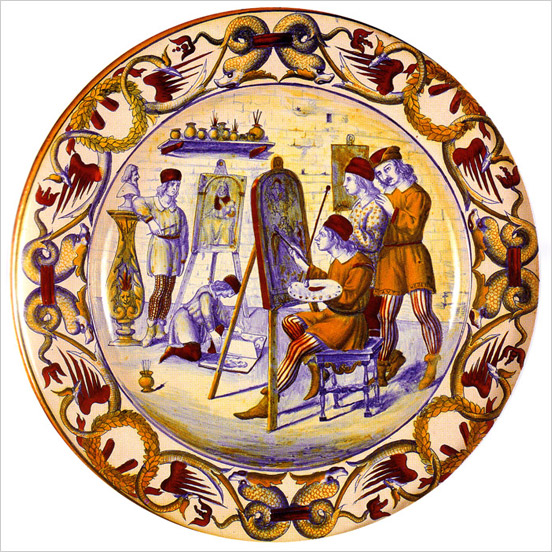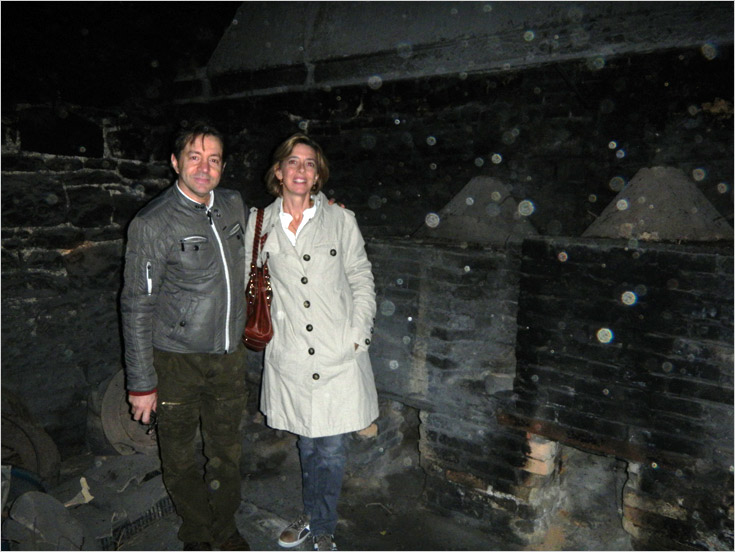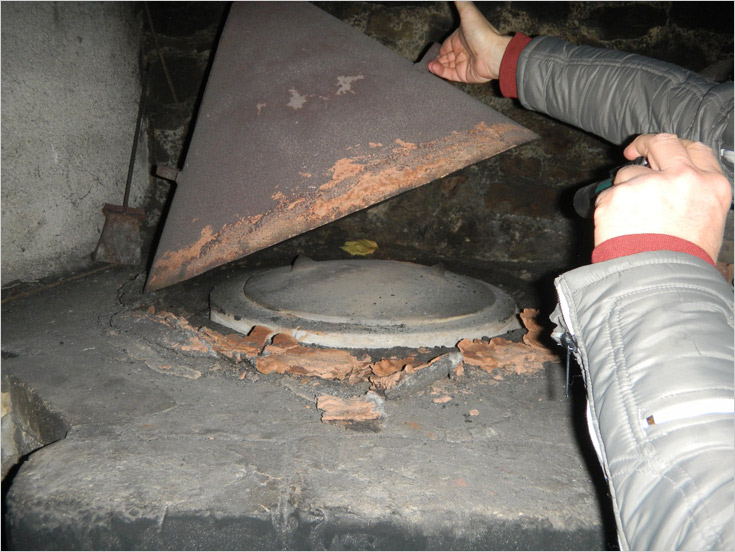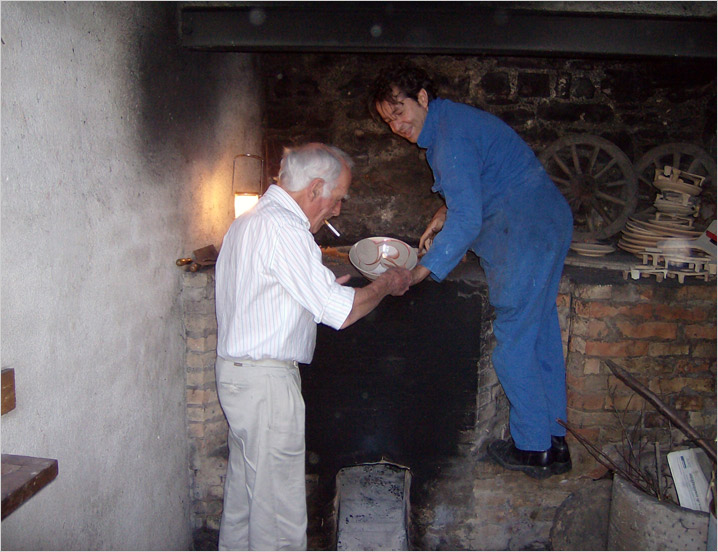Last Friday is a day to remember. Manuela and I met Maurizio Tittarelli Rubboli in Gualdo Tadino, his home town. He had invited us to see his old kilns or “muffole”, dating back to 1884 and 1920.
a day to remember. Manuela and I met Maurizio Tittarelli Rubboli in Gualdo Tadino, his home town. He had invited us to see his old kilns or “muffole”, dating back to 1884 and 1920.
Gualdo is a small village, nested on the first spurs of the Appennini, not too far from Perugia. We parked near the Rocca Flea, a massive fortified castle from the 13th century. Maurizio was waiting to show us the old Fabbrica Rubboli, just a few steps downhill.
The place does need to be restored! It’s a long stone building, now completely decaying, that is supposed to become the future Rubboli Museum. How far into the future, no one knows, unfortunately. Actually, Maurizio is fighting tooth and nail to protect the heritage of his illustrious ancestors and that of the pottery from Gualdo Tadino and kick off the project of the Museum … but this is another story.
He showed us some rooms of the old Fabbrica. They hide invaluable 19th and 20th century molds and tools, carelessly heaped in an old room without any protection. Fascinating, yet so sad to watch.
The old kilns stand next to the main building. They were built in 1884 to fire lusterware, since this was the primary business of Maurizio’s most illustrious ancestor, Paolo Rubboli. One quick step back is necessary at this point.
 Paolo Rubboli (1838-1890) is the artist who earned Gualdo Tadino its strong reputation for pottery, particularly lusterware. He moved to the city around 1875 and established there his studio. He had worked with Fabbri and Carocci from Gubbio and had learnt the secrets of golden and ruby glazes.
Paolo Rubboli (1838-1890) is the artist who earned Gualdo Tadino its strong reputation for pottery, particularly lusterware. He moved to the city around 1875 and established there his studio. He had worked with Fabbri and Carocci from Gubbio and had learnt the secrets of golden and ruby glazes.
His perfect iridescence soon became a celebrated feature of his pottery, designed and decorated according to the dominant taste for Historicism, an art movement that developed after the Italian unification (1860’s). Paolo bequeathed the secrets of his art to his family, and Maurizio is one of the last descendants.
 The kilns that Maurizio showed us, the muffole, were build following the designs made by Cipriano Piccolpasso in 1548. They are the last ones left in Italy and they are simply STUNNING.
The kilns that Maurizio showed us, the muffole, were build following the designs made by Cipriano Piccolpasso in 1548. They are the last ones left in Italy and they are simply STUNNING.
We stepped in with a mixed feeling of reverence and wonder, the rooms still resounding of the voices of the many generations that skilfully lit the fire under the muffole, filled them with painstakingly hand painted ceramics, patiently checked the progress of the firing on the small testers and finally, opened the muffole to experience the “miracle of iridescence”.
Maurizio was a splendid host, patiently going thru the details of the kilns structure. He still uses one of them for his amazing luster pottery. He certainly makes the best of the his family secrets.
 He told us that the ingredients for the iridescent glazes are not that hard to find, although some of them are sold for completely different purposes and certainly they can’t be bought in art and craft supply stores. He usually works in Perugia, where his pottery goes thru the first and the second firing. When the pieces are ready for the third, most unpredictable firing, he drives to Gualdo. At 4 a.m. he starts the fire under the muffola and proceeds to repeat the same gestures that Paolo Rubboli made more than a century ago. In that same place.
He told us that the ingredients for the iridescent glazes are not that hard to find, although some of them are sold for completely different purposes and certainly they can’t be bought in art and craft supply stores. He usually works in Perugia, where his pottery goes thru the first and the second firing. When the pieces are ready for the third, most unpredictable firing, he drives to Gualdo. At 4 a.m. he starts the fire under the muffola and proceeds to repeat the same gestures that Paolo Rubboli made more than a century ago. In that same place.
 Last Summer Alan Caiger Smith was invited in Gualdo for the opening of the exhibition “The Rubboli Collection”. He flew from London with a precious bowl sitting on his lap. He had made it especially for the event, preparing it for the third and final firing in the famous kiln he had heard so much about. Maurizio showed us some pictures of Alan Caiger Smith closely watching the process of the firing and waiting for the miracle to happen. It did.
Last Summer Alan Caiger Smith was invited in Gualdo for the opening of the exhibition “The Rubboli Collection”. He flew from London with a precious bowl sitting on his lap. He had made it especially for the event, preparing it for the third and final firing in the famous kiln he had heard so much about. Maurizio showed us some pictures of Alan Caiger Smith closely watching the process of the firing and waiting for the miracle to happen. It did.
After the visit we walked together to the exhibition, still open in the Chiesa di San Francesco. Visiting it with Maurizio proved an amazing experience. Not only he knows every detail of the pieces on display – of course! – but he has this innate quality that allows him to pick the most juicy stories and to infuse them with his irrepressible enthusiasm.
Both Manuela and I bought the catalog of the exhibition. We do wish to learn more about the Rubbolis and their amazing contribution to ceramic art. But this is yet another story.
Related articles
Lumen et Splendor
Lumen et Splendor – Live Report
The Rubboli Collection – Italian lustre pottery in Gualdo Tadino
Gubbio honors Alan Caiger-Smith

You may want to contact the Rubboli Assciation. They’ll be happy to help. Their email address is associazionerubboli@fastwebnet.it
I have 2 peices of signed Paolo Rubboli pottery and wonder where I can get them appraised. Thanks